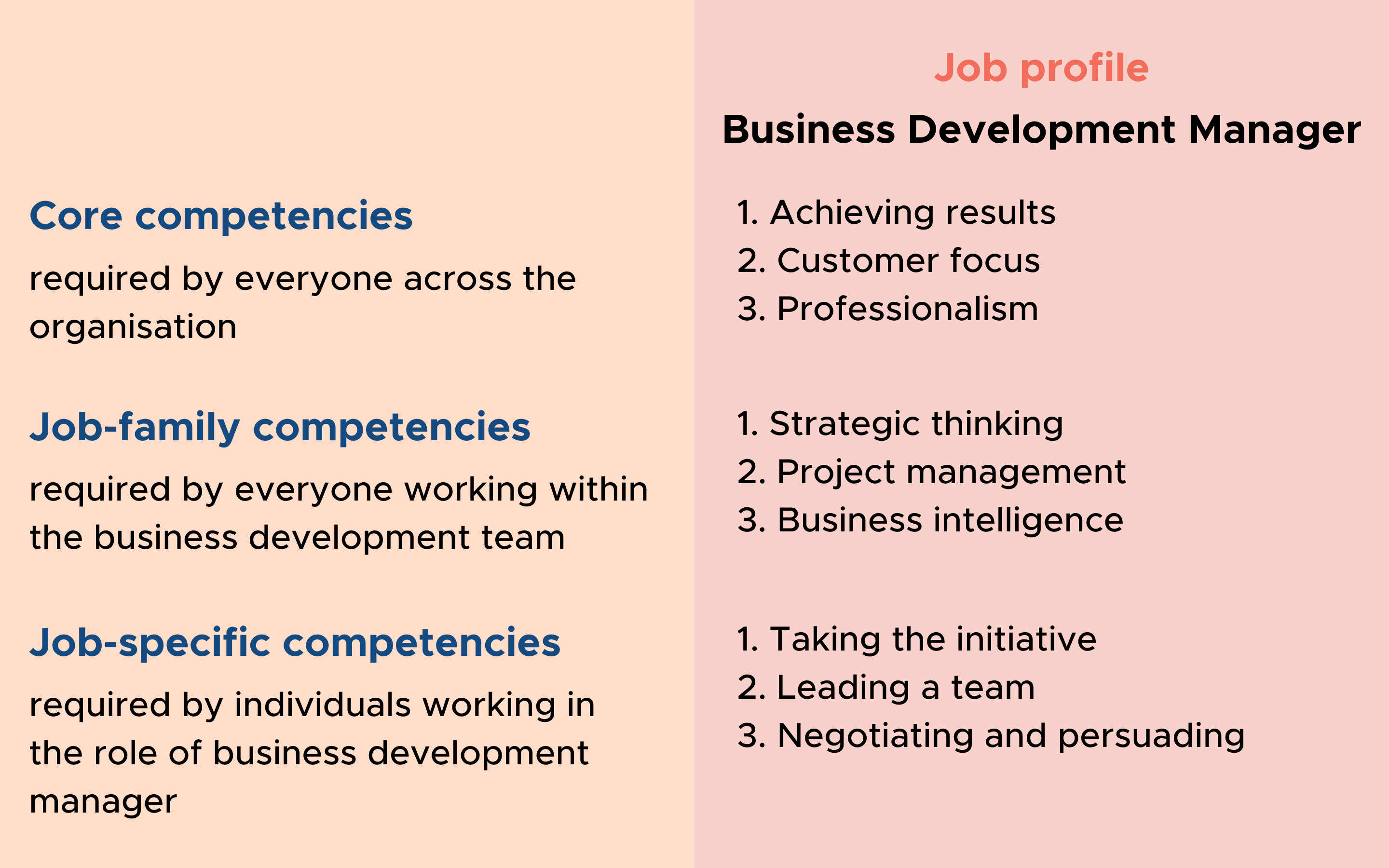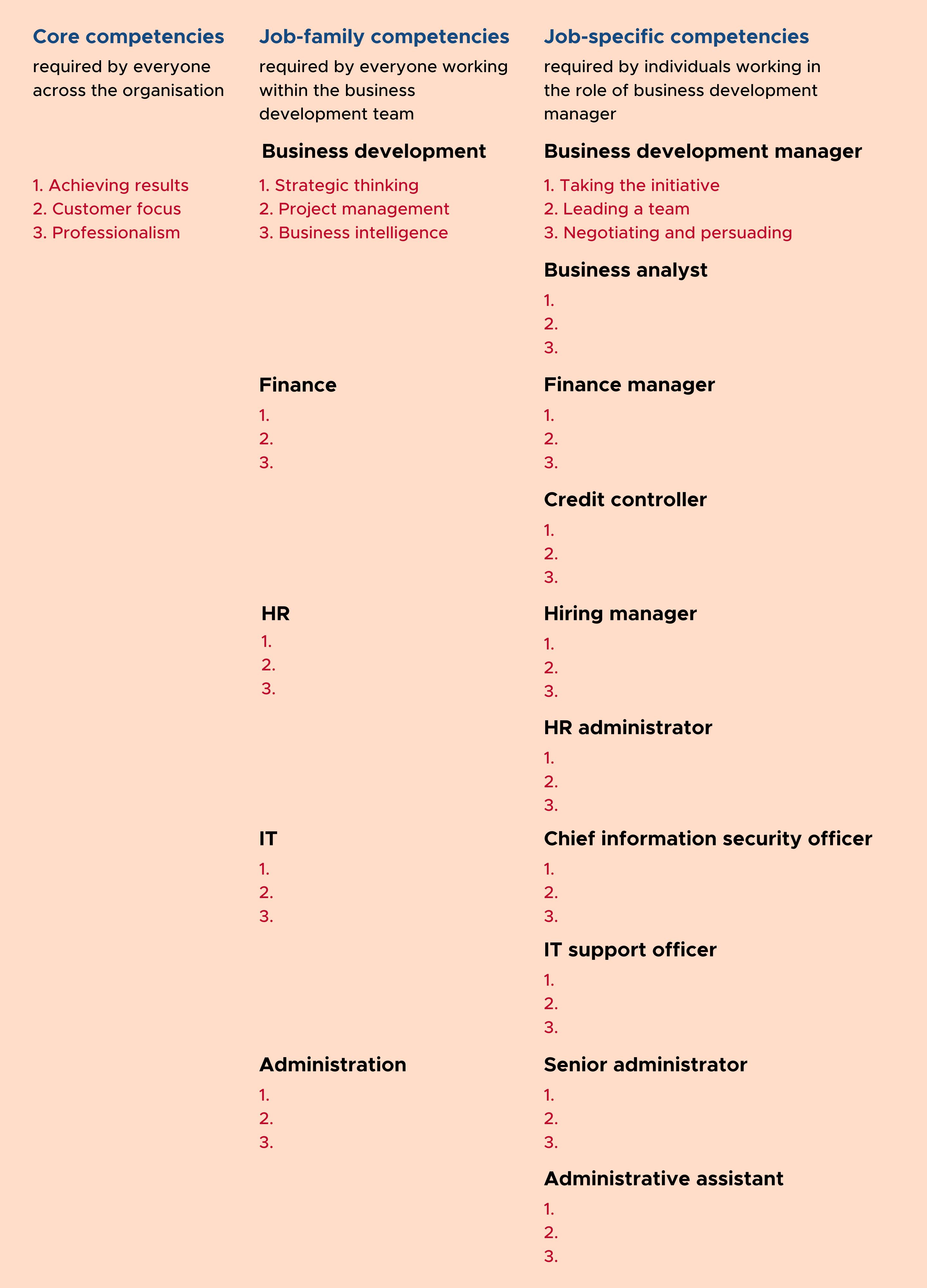10 Minutes of reading
Skills vs competencies: what is the difference?
Many people tend to think of skills and competencies as similar or even synonymous with one another, but in a learning context there are important differences between the two.
Here, we’ll explain how skills and competencies differ and take a look at how organisations can use this knowledge to establish a competency framework – an invaluable tool when it comes to upskilling or reskilling employees.

What is a skill?
A skill is an ability to achieve a specific result in a specific setting. It can either be learned by experience or through training and can be acquired at a basic, intermediate or expert level.
Essentially, skills are the ‘what’: what are you intending to achieve? For example, if you’re lost in a foreign country and need to ask for directions in Spanish, you’ll need to be able to speak Spanish well enough to communicate your needs and achieve the intended result (i.e., get directions).
Skills don’t have to be cognitive – they can be manual, too, such as being able to repair a bicycle or change a lightbulb.
Moreover, in a professional context, we often talk about hard and soft skills. Hard skills are technical and measurable, such as computer skills, while soft skills cover attributes that we tend to associate with emotional intelligence, such as being patient or being a good listener.
What is a competency?
A competency, on the other hand, combines skills with knowledge and behaviour. In this sense, a competency has a much broader definition than a skill does.
We can think of competencies as the ‘how’: how are you achieving an intended result? To illustrate this, let’s go back to the foreign language scenario outlined above. Speaking Spanish at a basic level is likely to be enough to make yourself understood and get directions. But if you work as a professional interpreter, for example, you’re likely to require a high level of linguistic skill, as well as cultural knowledge, and will need to exhibit culturally appropriate behaviour. In this sense, interpreters are not just skilled in Spanish – they are competent professionals.
How are skills and competencies similar?
Skills and competencies are similar in that they can both by acquired through training and experience, and they both represent an ability.
How are skills and competencies different?
As mentioned above, we can think of skills as the outcome and competencies as the means of achieving an outcome. So, while employees require a certain set of skills in order to perform their job well, they also display competencies that determine how they perform their job (i.e., skills, knowledge and behaviours).
But how are skills and competencies different? To illustrate this, let’s take the example of a violinist.

To be able to perform in an orchestra, a violinist will need to be able to possess the technical skill of playing the violin. This is non-negotiable, and we can think of this as a basic requirement of the job. However, there’s much more to being a good performer than pure technical skill.
This is where the idea of competency comes in. For instance, someone could be the most skilled violinist in the world, but what if they get nervous in front of an audience and are unable to perform in a live situation? In this sense, possessing a hard skill is not enough; the individual also needs to be able to perform well under pressure, manage their nerves and believe in themselves. Moreover, if they are working as part of a group, being able to get along well with others and having a positive attitude will also be real assets in the role.
This example also serves to demonstrate that skills don’t exist in a vacuum. While finding someone who can play the violin to an excellent standard will clearly be a high priority for a music school recruiting their next performer, the ideal candidate will need to possess additional hard skills, such as being able to read music. They will also need to possess the relevant musical knowledge and the ability to work with others, multitask and deal with unpredictability to succeed as a competent musician. (Remember, competencies = skills + knowledge + ability).
Competency types and examples
In a professional context, we can break down competencies into three main types.
Behavioural competencies are the innate or natural behaviours demonstrated by employees. This could be working well with others, being creative or having the ability to diffuse tension.
Technical competencies are the skills and knowledge required in specialised fields. For example, financial planning is a competency required by those working in a company’s finance department.
Leadership competencies combine the skills, knowledge and ability required to be a good leader. For example, social intelligence requires being able to understand others’ behaviour (skill), know your team well (knowledge) and work effectively in social situations (ability).
Developing a competency framework
Now that we’ve outlined the differences between skills and competencies, it’s worth considering how this knowledge can be applied to develop a competency framework.
A competency framework is essentially a model for performance excellence. It presents a list of competencies that can be applied to several roles and departments across an organisation.
It goes without saying that all companies want to achieve performance excellence, but how this excellence is achieved will differ depending on an organisation’s structure, vision and approach. For this reason, a competency framework is unique to every organisation and requires careful consideration.
The good news is that, once developed, a competency framework not only enables organisations to clarify the behaviours and attributes they are looking for in new recruits but also to assess how well their existing employees are performing against established standards. It provides a common understanding of an organisation’s values and sets out how each individual employee can play their part in driving excellence.
How to define your competency architecture
The first step in developing a competency framework is to ascertain the competencies present within your organisation. You can break down these competencies into:
Core competencies – these should be upheld by all staff, regardless of their job title or level of seniority. Core competencies tend to be closely aligned with an organisation’s values. For instance, integrity, respect for others, honesty and professionalism are highly valued by many private and public organisations and tend to feed into their core competencies.
Job-family competencies – these relate to the competencies required by employees working in the same functional occupation. For example, employees working in HR are likely to need the same basic training, qualifications and skills, regardless of whether they are working as an entry-level HR administrator or senior HR manager.
Job-specific competencies – these relate to a specific job and will depend on the complexity of the role and level of responsibility required.
With these categories in mind, you can then develop a job profile for a specific role. A job profile for a business development manager might look something like this:

You can then map out the competencies across your organisation as a whole. For instance, while the core competencies shown in the left-hand column will remain the same, regardless of job family or position, you might decide that you want to include three job-family specific competencies and three job-specific competencies for each role.
As a general rule, the competencies will likely become more specific as you move from left to right across the grid.

Once established, fleshed out and consolidated in an organisational framework, these competencies can be included in job vacancy adverts and assessed throughout the recruitment process to ensure that potential candidates have exactly the right competencies required.
For example, based on the Business Development Manager profile, an appropriate behavioural interview question might be: ‘Can you describe a time when you had to lead a team to success?’ (job-specific competency 2; leading a team). Similarly, a relevant situational judgement question might be something like this: ‘You have identified a potential new market that you think your team should explore, but everyone is already very busy, and no one seems interested in taking on the extra work. How would you persuade them that this new market is worth exploring?’ (job-specific competency 3; negotiating and persuading).
The benefits of developing your organisation’s competency profile
New skills for a changing world: reskilling
First of all, by gaining an overview of all the competencies you have available, you can gain key insight into your business – intelligence that you simply might not have been aware of otherwise. For example, you might be surprised to see some overlap between job-specific competencies for roles that you might not have thought were very similar. Taking the initiative, for example, might be equally as important in a business development role (to generate new leads) as in an IT support officer role (to find proactive solutions to problems).
Drawing these parallels between job roles and responsibilities is becoming increasingly important, given that the world of work is undergoing a huge transformation. Many of the jobs that employees are currently engaged in won’t exist by 2030 – meaning that companies will need to find ways to reskill and repurpose their existing workforce. By gaining an overview of the competencies available, organisations can start undertaking some strategic planning of their human resources in order to enhance their workforce resilience and future-proof their operations.
Maintaining a competitive edge: upskilling
As well as providing an opportunity for reskilling (i.e., providing training to employees to enable them to learn the skills required for an entirely different job), developing a competency framework can also provide an opportunity for upskilling, as organisations can see what competencies they are either lacking completely or need to improve on.
For instance, it might become clear that there is an inordinate focus on teamwork-based competencies when in fact your organisation has been striving to give your employees greater accountability and autonomy. Are the competencies outlined in the framework truly in line with what the business is trying to achieve? Are any of the competencies at odds with one another?
Establishing your organisation’s competency profile is therefore a great opportunity to really get to the heart of what your organisation represents and wants to achieve by means of its human resources. In this sense, it’s worth bearing in mind the language you use to define competencies in the first place (i.e., semantics). For instance, if you’re keen to embed a culture of innovation, you could perhaps shift the focus away from ‘taking the initiative’ and instead emphasise the importance of ‘trialling new ideas’.
Competency frameworks: a vital business intelligence tool
Gaining an understanding of the competencies available can enable organisations to identify competency gaps, discrepancies and areas for improvement, which can be addressed through dedicated reskilling or upskilling training programmes for employees.



